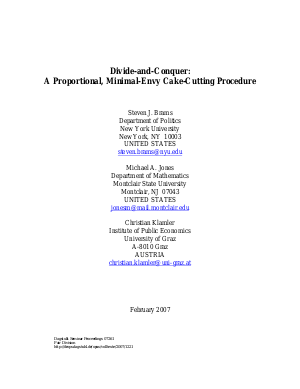Divide-and-Conquer: A Proportional, Minimal-Envy Cake-Cutting Procedure
Authors Steven J. Brams, Michael A. Jones, Christian Klamler
-
Part of:
Volume:
Dagstuhl Seminar Proceedings, Volume 7261
Part of: Series: Dagstuhl Seminar Proceedings (DagSemProc) - License:
 Creative Commons Attribution 4.0 International license
Creative Commons Attribution 4.0 International license
- Publication Date: 2007-11-26
File

PDF
DagSemProc.07261.6.pdf
- Filesize: 247 kB
- 31 pages
Document Identifiers
Subject Classification
Keywords
- Cake-cutting
- proportionality
- envy-freeness
- efficiency
- strategy-proofness
Metrics
- Access Statistics
-
Total Accesses (updated on a weekly basis)
0Document
0Metadata
Abstract
Properties of discrete cake-cutting procedures that use a minimal number of cuts (n-1 if there are n players) are analyzed. None is always envy-free or efficient, but divide-and-conquer (D&C) minimizes the maximum number of players that any single player may envy. It works by asking n ≥ 2 players successively to place marks on a cake that divide it into equal or approximately equal halves, then halves of these halves, and so on. Among other properties, D&C (i) ensures players of more than 1/n shares if their marks are different and (ii) is strategyproof for risk-averse players. However, D&C may not allow players to obtain proportional, connected pieces if they have unequal entitlements. Possible applications of D&C to land division are briefly discussed.
Cite As Get BibTex
Steven J. Brams, Michael A. Jones, and Christian Klamler. Divide-and-Conquer: A Proportional, Minimal-Envy Cake-Cutting Procedure. In Fair Division. Dagstuhl Seminar Proceedings, Volume 7261, pp. 1-31, Schloss Dagstuhl – Leibniz-Zentrum für Informatik (2007)
https://doi.org/10.4230/DagSemProc.07261.6
BibTex
@InProceedings{brams_et_al:DagSemProc.07261.6,
author = {Brams, Steven J. and Jones, Michael A. and Klamler, Christian},
title = {{Divide-and-Conquer: A Proportional, Minimal-Envy Cake-Cutting Procedure}},
booktitle = {Fair Division},
pages = {1--31},
series = {Dagstuhl Seminar Proceedings (DagSemProc)},
ISSN = {1862-4405},
year = {2007},
volume = {7261},
editor = {Steven Brams and Kirk Pruhs and Gerhard Woeginger},
publisher = {Schloss Dagstuhl -- Leibniz-Zentrum f{\"u}r Informatik},
address = {Dagstuhl, Germany},
URL = {https://drops.dagstuhl.de/entities/document/10.4230/DagSemProc.07261.6},
URN = {urn:nbn:de:0030-drops-12211},
doi = {10.4230/DagSemProc.07261.6},
annote = {Keywords: Cake-cutting, proportionality, envy-freeness, efficiency, strategy-proofness}
}
